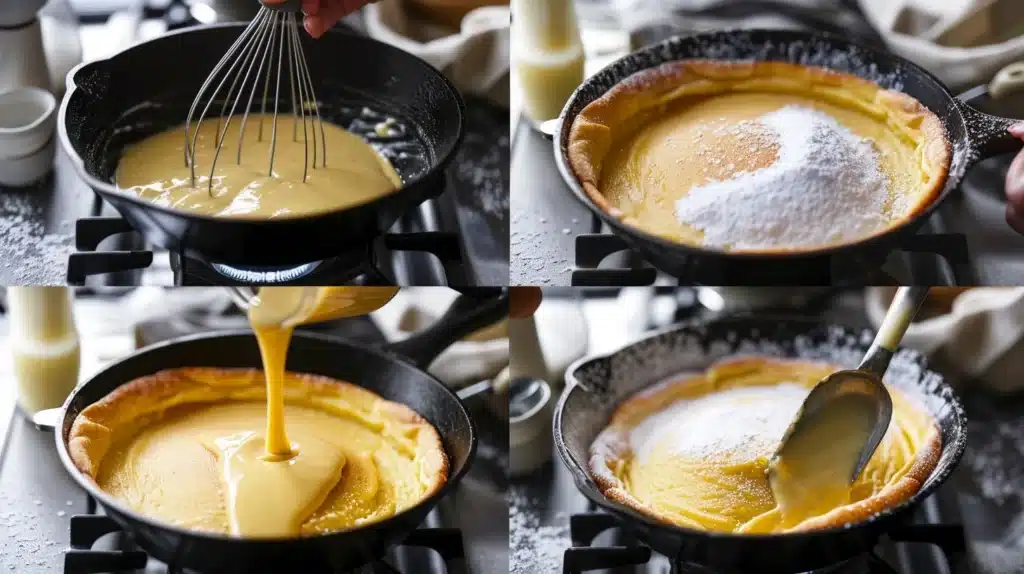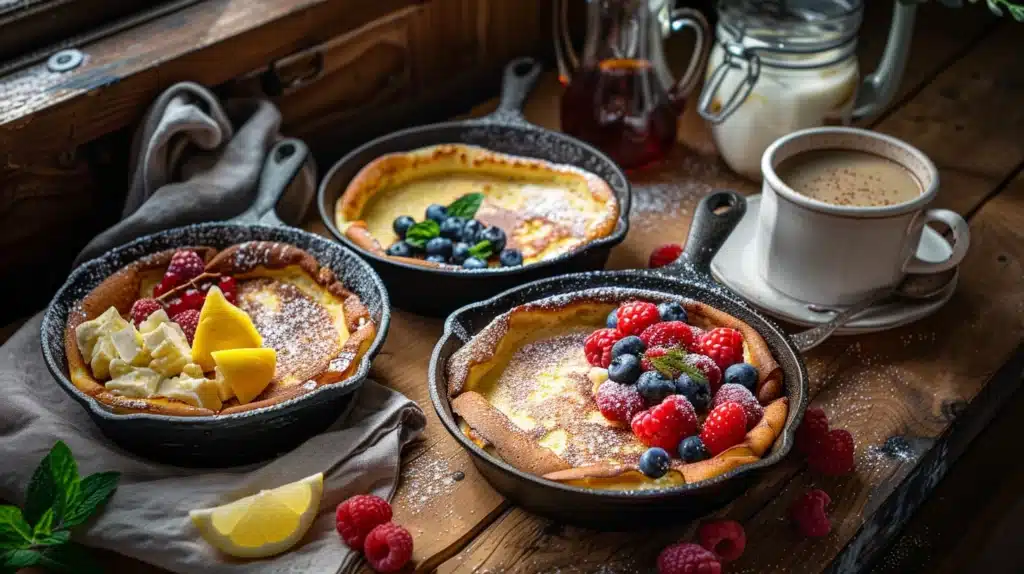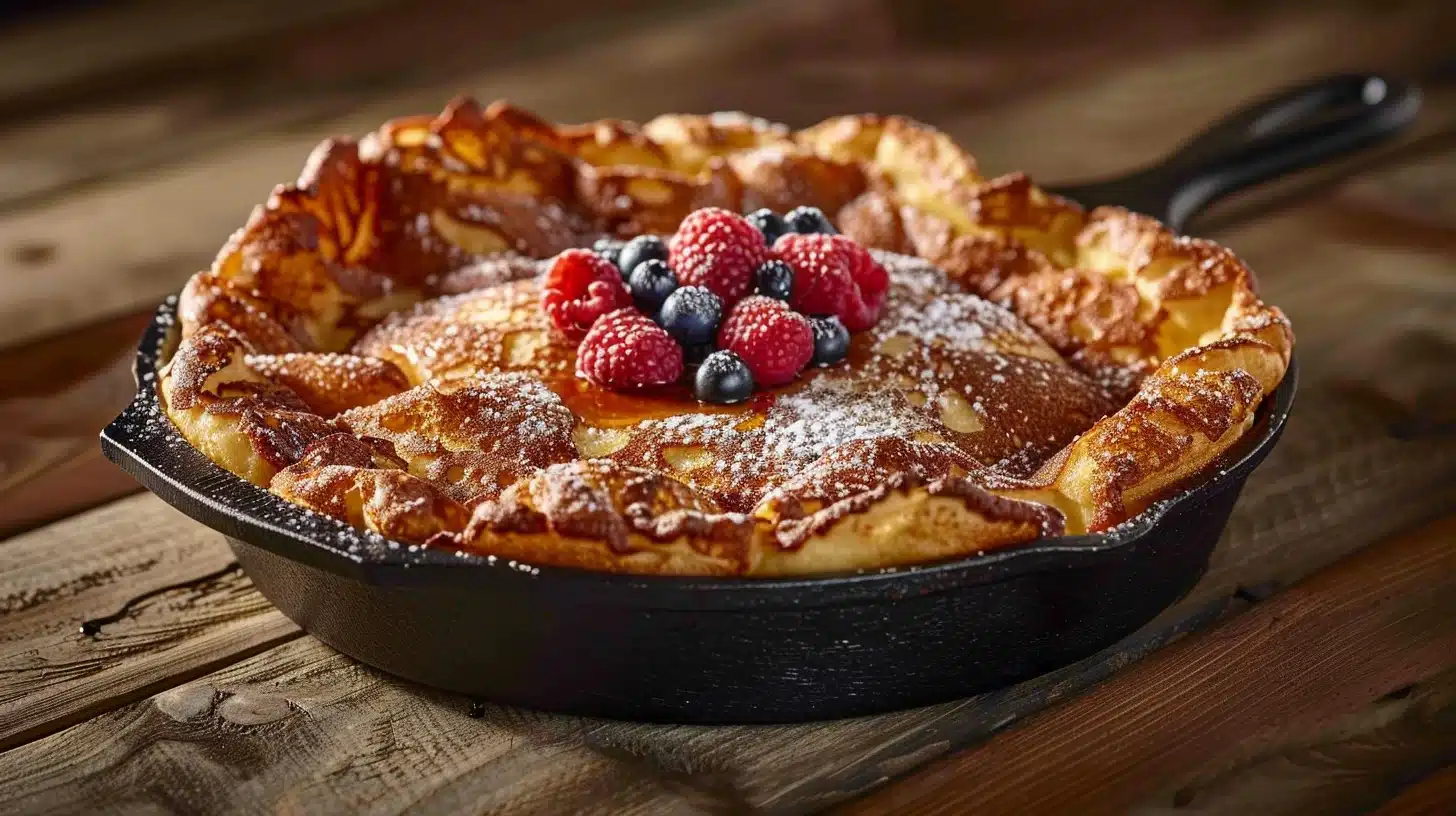If you’ve never had a Dutch baby pancake, you’re in for a treat! Imagine a giant, fluffy pancake that puffs up beautifully in the oven, with crispy edges and a custardy center. It’s like a mix between a pancake, a popover, and a crepe—all baked in one pan.
This dish is perfect for breakfast, brunch, or honestly, any time you’re craving something special but don’t want to spend hours in the kitchen. Plus, you can top it with powdered sugar, syrup, fresh fruit, or even go savory—so it’s as versatile as it is delicious.
In this guide, we’ll break down everything you need to know to make the best Dutch baby recipe at home. From its history to the best ingredients, step-by-step instructions, common mistakes, and even some creative toppings—you’ll be a pro by the time you finish reading. So grab your skillet, and let’s get started!
Introduction to Dutch Baby Pancakes
What is a Dutch Baby Pancake?
A Dutch baby pancake (also called a German pancake) is a big, oven-baked pancake that puffs up dramatically as it cooks. Unlike traditional pancakes that require flipping, this one is baked in a hot cast iron skillet in the oven. The result? Crispy edges, a soft, slightly custardy center, and a show-stopping presentation that makes it look like you spent way more effort than you actually did.
Despite its name, a Dutch baby isn’t actually Dutch—it’s more of an American twist on a German dish known as Pfannkuchen. But more on that in a second!
Origins and History of the Dutch Baby
The Dutch baby pancake traces its roots back to German immigrants who brought their Pfannkuchen recipe to the U.S. in the early 1900s. The term “Dutch baby” was reportedly coined by a Seattle-based restaurant called Manca’s Café in the 1940s. The story goes that the owner’s daughter mispronounced “Deutsch” (the German word for “German”) as “Dutch,” and the name stuck.
Unlike American pancakes, which rely on baking powder for fluffiness, a Dutch baby gets its dramatic rise from eggs, milk, and flour whisked together into a thin batter. When poured into a preheated cast iron skillet and baked at high heat, the steam inside causes it to puff up like magic.
Today, you’ll find endless variations of this dish—sweet, savory, mini-sized, or loaded with toppings. No matter how you make it, one thing’s for sure: it’s a total crowd-pleaser.
Ingredients Needed for a Classic Dutch Baby
Essential Components
Making a Dutch baby recipe is surprisingly simple. You only need a handful of pantry staples—no fancy ingredients, just good old-fashioned basics. Here’s what you’ll need:

- Eggs – The key to that puffed-up magic! They provide structure and help trap steam for the rise.
- Milk – Whole milk works best for a rich, custardy texture. You can use 2%, but avoid skim milk.
- Flour – All-purpose flour is perfect. It gives the pancake just enough body while keeping it light.
- Butter – A generous amount of melted butter ensures crispy edges and adds a rich flavor.
- Salt – Just a pinch to enhance the overall taste.
- Vanilla extract – Optional, but it gives a sweet, aromatic depth to the batter.
- Sugar – A little sugar adds a touch of sweetness, though you can adjust based on toppings.
Optional Add-ins and Variations
Once you’ve mastered the classic Dutch baby recipe, it’s time to have some fun. Try these add-ins to switch things up:
- Cinnamon or nutmeg – Adds warmth and depth, especially great for fall mornings.
- Lemon zest – Brightens up the flavor and pairs well with powdered sugar.
- Cocoa powder – Mix in a little for a chocolate twist.
- Savory mix-ins – Skip the sugar and vanilla, then add cheese, herbs, or crumbled bacon.
Feel free to experiment—this recipe is forgiving, and small tweaks can lead to delicious surprises!
Step-by-Step Guide to Preparing the Batter
Mixing the Batter: Tips and Techniques
Getting a perfectly puffed Dutch baby starts with the batter. It’s almost too easy—just whisk everything together! But for the best results, keep these tips in mind:
- Blend it up – A blender works wonders for creating a smooth, lump-free batter. If you don’t have one, whisk vigorously by hand.
- Room temperature ingredients – Cold eggs and milk can slow down the rise. Let them sit out for about 15 minutes before mixing.
- Thin consistency – The batter should be much thinner than the pancake batter—closer to heavy cream. This allows it to spread quickly and puff properly.
Simply mix the eggs, milk, flour, salt, sugar, and vanilla until smooth. You’re already halfway there!
Resting the Batter: Importance and Timing
This step is optional, but if you want the fluffiest, most consistent Dutch baby recipe, let the batter rest for at least 15–30 minutes before baking. Here’s why:
- Better gluten development – Resting helps the flour fully absorb the liquid, leading to a smoother texture.
- More consistent puff – A well-rested batter results in a more even rise in the oven.
- Easier to work with – A slightly thicker batter pours and spreads better in the pan.
If you’re short on time, don’t stress! Your pancake will still turn out great, but if you have a few extra minutes, the wait is worth it.
Cooking the Dutch Baby Pancake
Choosing the Right Pan: Cast Iron vs. Alternatives
When making a Dutch baby recipe, the pan you choose plays a big role in how your pancake turns out. A cast iron skillet is the top pick because it holds heat well, giving you those crispy edges and a fluffy center. If you don’t have one, don’t worry—you can use an oven-safe non-stick skillet or a heavy stainless steel pan. Just make sure it’s oven-safe and can handle high temperatures.

Preheating and Buttering the Pan
Getting your pan hot before adding the batter is key to a perfect Dutch baby. Here’s how:
- Preheat the oven to 425°F (218°C) with the skillet inside. This ensures the pan is evenly heated.
- Once the oven reaches the right temperature, carefully remove the hot skillet (use oven mitts!). Add 2 tablespoons of unsalted butter, swirling it around until it melts and coats the bottom and sides. This not only adds flavor but also keeps the pancake from sticking.
Baking Process: Temperature and Timing
Now, let’s get that batter into the oven:
- Pour the prepared batter into the hot, buttered skillet. The heat will start cooking the edges right away.
- Place the skillet back in the oven on the middle rack. Bake for 20-25 minutes without opening the oven door. This prevents heat loss and ensures a good rise.simplyrecipes.com
- Keep an eye on the pancake through the oven window. It’s done when the edges are golden brown and puffed up, and the center is set.
- Once baked, remove the skillet from the oven. The pancake will deflate a bit as it cools—that’s normal.
Remember, practice makes perfect. Each oven is different, so you might need to tweak the time or temperature to get your ideal Dutch baby.
Serving Suggestions and Toppings
Traditional Toppings: Lemon and Powdered Sugar
The classic way to enjoy a Dutch baby is simple yet delicious:
- Lemon Juice: Squeeze fresh lemon juice over the warm pancake. The citrusy zing cuts through the richness.
- Powdered Sugar: Dust a generous amount on top. It adds sweetness and a lovely contrast to the lemon.
This combo highlights the pancake’s flavor without overpowering it.
Creative Variations: Fruits, Syrups, and Savory Options
Fresh Berries: Add strawberries, blueberries, or raspberries for a burst of freshness.
- Maple Syrup or Honey: Drizzle for extra sweetness.
- Nutella or Chocolate Spread: For the chocoholics out there.
- Sautéed Apples with Cinnamon: Cook apple slices with butter and cinnamon for a cozy topping.
- Savory Twist: Skip the sugar and vanilla in the batter. Top with sautéed mushrooms, grated cheese, or herbs for a brunch option.

Common Mistakes to Avoid
Even though a Dutch baby recipe is easy, a few simple mistakes can mess up your masterpiece. Don’t worry—I’ve got you covered! Here are the most common pitfalls and how to avoid them.
Overmixing the Batter
It’s tempting to keep whisking until everything looks perfect, but overmixing creates too much gluten, making your pancake dense and chewy instead of light and airy. Instead:
- Blend or whisk until just combined—a few lumps are okay!
- If using a blender, pulse a few times rather than running it non-stop.
Incorrect Oven Temperature
If your Dutch baby isn’t puffing up, your oven might be too cold! This pancake thrives on high heat—anything lower than 425°F (218°C) and you’re in trouble.
- Always preheat your oven—let it run for at least 10 minutes before baking.
- Use an oven thermometer if you’re unsure. Some ovens run cooler than their settings!
Using the Wrong Pan Size
Size matters! A 10 to 12-inch cast iron skillet is ideal. Too big, and the batter spreads too thin. Too small, and it might not cook evenly.
If you’re using a different pan:
- Adjust the baking time slightly. A smaller pan might need a minute or two longer.
Frequently Asked Questions (FAQs)
A Dutch baby is made from simple ingredients you probably already have. You’ll need eggs, flour, milk, sugar, butter, and a pinch of salt. Some recipes add vanilla or cinnamon for extra flavor. The batter is thin, almost like a crepe mixture. When baked, it puffs up beautifully, creating crispy edges and a soft, custardy center. The best part? It’s easy to customize! You can top it with powdered sugar, fresh fruit, or syrup. It’s a simple yet impressive breakfast dish that feels fancy but takes little effort. You’ll love how easy it is!
A Dutch baby has a few fun names! Some people call it a German pancake. Others know it as a Dutch puff or a Bismarck. Despite its name, it’s not Dutch at all! It comes from the German dish Pfannkuchen. The name “Dutch baby” is believed to have come from a mispronunciation of “Deutsch” (which means German). No matter what you call it, one thing is certain—it’s delicious! This pancake is a showstopper, rising high in the oven and making breakfast extra special. Try making one, and you’ll see why it’s so popular!
Dutch babies rise because of steam and eggs—no baking powder or yeast needed! First, the eggs trap air when blended. Then, when the batter hits the hot pan, the milk and butter create steam. That steam expands, lifting the pancake as it bakes. The hot oven keeps everything rising until the edges turn golden and crisp. It’s almost like magic! But don’t be surprised when it deflates after you take it out. That’s normal! The dramatic puffiness settles down, leaving a deliciously soft and slightly crispy pancake. That’s why eating it fresh from the oven is the best part!
The science behind a Dutch baby is all about steam! The high moisture from eggs and milk turns to steam when heated. This causes the batter to puff up quickly. Unlike regular pancakes, a Dutch baby doesn’t use baking powder or soda. Instead, eggs provide structure, and the hot skillet gives it a sudden lift. The edges crisp up, while the center stays soft. As soon as it leaves the oven, it collapses—don’t worry, that’s normal! It’s like watching a souffle in action. That’s why baking it in a preheated pan is key. Science makes this pancake so fun!
LSI and NLP Keywords Related to Dutch Baby Pancakes
To make your Dutch baby recipe more discoverable, here are some related keywords that can help with search rankings:
- German pancake recipe
- Oven pancake
- Puffy pancake
- Cast iron pancake
- Breakfast skillet pancake
- Sweet and savory pancakes
- Easy brunch ideas
- Baked pancakes with eggs
- Best fluffy pancakes
Using these variations naturally in your writing helps search engines connect your content with more readers who are looking for similar recipes!
Conclusion
And there you have it—your ultimate guide to making the perfect Dutch baby recipe! Whether you’re sticking with classic powdered sugar and lemon or getting creative with sweet and savory toppings, this fluffy, oven-baked pancake is always a winner.
The best part? It’s so easy to make, yet looks fancy enough to impress guests. Now that you know the tricks—the right pan, hot oven, and simple batter—you’ll be flipping out Dutch babies like a pro.
Ready to whip up another delicious dish? Check out our other breakfast recipes for more mouthwatering ideas!
Print
The Ultimate Guide to Making a Perfect Dutch Baby Pancake
- Total Time: 30-35 minutes
- Yield: 2–4 servings 1x
Description
This Dutch Baby Pancake is a magical, puffy oven-baked pancake with crispy edges and a soft, custardy center. With just a handful of ingredients, this show-stopping brunch recipe comes together in no time! Topped with powdered sugar, fresh fruit, or syrup, this versatile pancake is perfect for both sweet and savory variations. Ready in 30 minutes, it’s guaranteed to impress your family and guests!
Ingredients
Main Ingredients:
- 3 large eggs (room temperature)
- ¾ cup whole milk (room temperature)
- ¾ cup all-purpose flour
- 2 tablespoons granulated sugar
- ½ teaspoon salt
- 1 teaspoon vanilla extract (optional, for sweetness)
- ¼ teaspoon cinnamon or nutmeg (optional, for warmth)
- 2 tablespoons unsalted butter (for greasing the pan)
Optional Toppings:
- Powdered sugar – Classic & simple
- Fresh berries – Blueberries, raspberries, or strawberries
- Maple syrup or honey – For a sweet touch
- Lemon juice & zest – Brightens the flavor
- Nutella or chocolate drizzle – For chocoholics!
- Whipped cream – Light and fluffy
Instructions
Instructions:
Step 1: Preheat the Oven & Skillet
- Preheat your oven to 425°F (218°C).
- Place a 10- to 12-inch cast iron skillet in the oven while it preheats.
Step 2: Make the Batter
- In a blender, combine eggs, milk, flour, sugar, salt, vanilla (if using), and cinnamon/nutmeg. Blend until smooth, about 20-30 seconds.
- (No blender? Whisk vigorously in a bowl until lump-free.)
- Let the batter rest for 10-15 minutes while the oven finishes preheating. (Optional, but helps with better puff.)
Step 3: Heat the Skillet & Add Butter
- Once the oven is fully preheated, carefully remove the hot skillet using oven mitts.
- Add 2 tablespoons of butter to the skillet, swirling it around until melted and foamy.
Step 4: Bake the Dutch Baby
- Quickly pour the batter into the hot, buttered skillet.
- Immediately return the skillet to the oven.
- Bake for 20-25 minutes, or until the pancake is golden brown and dramatically puffed up. (Do NOT open the oven door while baking!)
Step 5: Serve & Enjoy!
- Remove from oven—the pancake will deflate slightly, which is normal.
- Dust with powdered sugar, squeeze over some lemon juice, and add your favorite toppings.
- Serve immediately while warm and fluffy!
🔥 Pro Tip: If making a savory Dutch baby, skip the sugar & vanilla in the batter and top with cheese, ham, or sautéed greens.
Notes
- Gluten-Free Option: Swap all-purpose flour with gluten-free flour blend.
- Dairy-Free Alternative: Use almond milk or oat milk and vegan butter.
- Savory Version: Skip sugar & vanilla, and top with cheese, bacon, or sautéed spinach.
- Chocolate Twist: Add 1 tablespoon cocoa powder to the batter for a rich, chocolatey Dutch baby!
Serving Suggestions:
✔ 🍋 Lemon & Powdered Sugar – The classic topping.
✔ 🍯 Maple Syrup & Nuts – For a cozy, nutty flavor.
✔ 🍓 Fresh Berries & Whipped Cream – Perfect for summer mornings.
✔ 🧀 Savory Toppings – Cheese, mushrooms, or crispy bacon for a brunch twist.
Storage & Meal Prep Tips:
- Refrigeration: Store leftovers in an airtight container for up to 2 days.
- Reheating: Warm in a 350°F oven for 5-7 minutes.
- Freezing: Not recommended, as the texture changes.
- Prep Time: 10 minutes
- Cook Time: 20-25 minutes
- Cuisine: German-American, Breakfast, Brunch
Nutrition
- Calories: ~240 kcal
- Sugar: ~7g
- Fat: ~9g
- Carbohydrates: ~32g
- Fiber: ~1g
- Protein: ~8g

